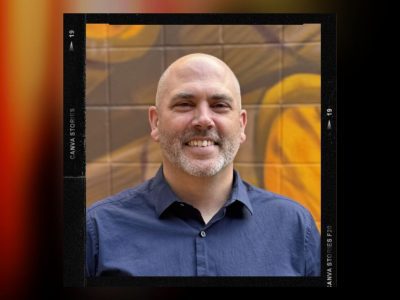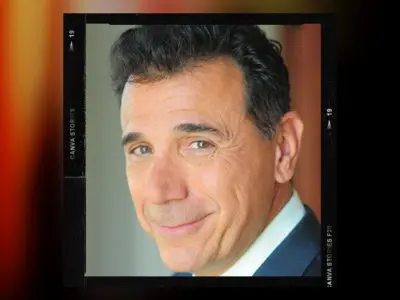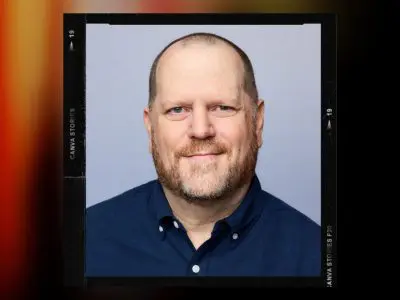Why Failure Doesn’t Suck
w/ Chris Dyer
Use the buttons above to listen now.
Transcript - Why Failure Doesn’t Suck
Rich: On this episode of Team Building Saves the World.
Chris: I’m talking about… Hey, I wonder if we could do this better. Let me try this other way. Oh, that didn’t work. Okay. Well, let’s talk about it. We call it the boo boo of the month award. And it was like, who, who screwed up the biggest? You’re not picking up a two pound weight to walk around with.
You’re picking up a 20 pound weight to go walk around with. Right. This is not an easy one to deal with. Well, why is it so hard?
Rich: Hello team. It’s me, your old friend, Rich Rininsland, host of team building saves the world. The show where I speak to thought leaders from around the world, discussing variable strategies and tools to help you and your team build a better work environment. And today I want you to sit back and forget about all your errors.
As we discuss winning through failure with the writer of such books as the power of. First and second editions, as well as the number one ranked leadership speaker, Chris Dyer. But first, I need to share some love with my supporters at Team Bonding. If your team is ready to experience teamwork for the power of play, then visit teambonding.
com to learn more. Now, team, join me in welcoming my guest, writer, TED speaker, leadership trainer, and zipline survivor, Chris Dyer. Chris!
Thank you so much for coming on board, Chris. It’s amazing to have you here. Let us, if you don’t mind, let’s start out nice and simple. Uh, just like I normally do tell my team out there a little bit about you, where you came from and how it is that failure and innovation in the workplace became your focus.
Chris: Well, yeah, I’m Chris Dyer and I like to say I just got really lucky and often one of the other things that besides maybe dealing with failure, I often remind people to say yes. And I think somewhere along the line, I just started saying yes to people when they asked, Hey, would you want to do this thing?
You want to try that? I was like, sure. I’ll do that. And they were like, do you know how? And I’m like, no, I do not. Um, you know, or, or they wouldn’t even ask me that question, right? Someone would say, can you go run this thing? And you go, sure. And they were just happy. Somebody said yes. Um, so I learned along the way, if you just keep saying yes, if you just keep trying to figure stuff out that you probably have absolutely no business doing, the great things happen.
And it led me to having a company. And that led me to. Speaking and writing books and I had my own podcast for 10 years. I mean, it was all just because somebody came along and was like, Hey, you want to do this thing? And I went, sure, I’ll try that. And then along the way, because you say yes to things you would never dream of.
You generally screw it up. You’re generally, you know, you make a lot of mistakes. You’ve got to figure stuff out. You got to ask a lot of questions. And so the idea of failure of I’m going to try it. I’m an experiment. I’m going to fix it. I’m gonna make it better. And I, I know I’m not going to get it right the first time because I have no business doing this job or this thing.
Anyways, I’m going to screw it up 50 times. And so that’s going to be. Kind of just became my, my, my, my operating system for, for a very long time. Well,
Rich: in your TEDx talk, you mentioned even how the fact that trying to avoid those mistakes you’re going to make along the way is the most detrimental thing that you can do.
Why is it that you feel that way? And how does that philosophy impact corporate culture?
Chris: I used to coach a lot of different sports teams, which is something my wife and I were kind of very passionate about. And I coached swimming, I coached water polo, I coached basketball, I coached soccer, uh, had competitive levels.
And what I noticed was with the kids who were trying not to lose. Well, the ones that did the worst, the teams that were afraid to lose, right, were really couldn’t ever get anywhere. Right. Um, and, and because they were constantly worried, you know, they, let’s say he was basketball, they dribbled down the court and they, you know, kick it out of bounds on accident.
And if that’s going to set you off for the rest of the day and you can’t recover from that, right, then how do you ever become a champion? How do you ever become great? And so that was something very early on, even with the kids I had to address that we, Hey, we’re We’re all going to make a hundred mistakes.
If you, if you’re going to go into this game thinking you’re never going to make a mistake, um, and you’re going to get upset when you do, we will never get anywhere. Right. So our, our goal is to maybe make a few less mistakes. This game, the last to have learned something to have gotten a little bit better, but like, that’s a part of the learning process.
Rich: Okay. But what is it that the corporate world is learning now about this? I mean, First of all, what is even failure? What does it look like when we talk about how we can actually, you know, make something beneficial from it?
Chris: So let’s define it. There’s mistakes and then there’s errors. And so what I’m not advocating for is to allow people to make errors all day long and just to be okay with it.
That is not what we’re talking about, okay? An error is I miscalculate payroll every time we do it. I don’t know how to use a calculator properly. A lot of people make these silly errors because they’re overworked, because they are micro, excuse me, they are multitasking, uh, because they’re not trained properly, they don’t have the right equipment or the right resources, and they make errors that could have been avoided, and that is not What we’re talking about here today, I’m talking about, Hey, I wonder if we could do this better.
Let me try this other way. Oh, that didn’t work. Okay. Well, let’s talk about it. Let’s figure out if there was something else I could have done. Right. So when we’re talking about making failing, we want to, we’re failing because we’re trying to do it better. The client calls and said, am I happy? Well, let me try this other way for you.
Let me experiment. Let me do something that might. Take me into a spot where I might, I might find this like magic. This happens rarely, but when it happens, you’re like a superstar at work. You discover this entirely new way of doing something that nobody else had ever thought of. And they call you a genius.
10 minutes before that you’d screwed it. You’d tried it three other ways, completely failed. And had they come along, then they would have called you a failure. But then you find this, this correct way. What I think is interesting to get to the heart of your question is that most great companies. Recognize that mistakes and this idea of, of, of, uh, intentional failure, right, is a part of their DNA and is a part of what they do.
And. Uh, 3M is a great example of this, that they understood, now they’re a company who invents and so they have inventions and experiments and so it’s naturally a part of their process to try something and fail. But they document things to such a degree, it’s insane. I mean, before there was computers, they had.
They had detailed notes. They had their own, like, you know, handwritten database of every experiment, everything that their, their teams and scientists had ever done to keep track of what happened in that process. So people could learn. So people didn’t have to repeat those. And so great companies have been doing this for a very long time.
It’s the rest of us idiots who have been. You know, showing up and just, you know, trying it and going, Oh, what is this? So I can do it this way. Wow. You know, and I think that’s not something taught in schools, not something taught in everyday life that you should go out and figure this out. And part of that is because not everybody.
Is built to do this, right? Recently I’m rereading, uh, Patrick Linceoni is the six geniuses of workplace. I think that’s what it’s called. I’m probably messing up the title slightly. And they talk about, he talks about how there’s like these six different types of geniuses, and it was a good reminder that there are certain geniuses of people and I’m one of them who goes, you know what, Hey, we could do this better.
Why, why do we do it this way? Right. And that’s a, that’s a strength for me. And for other people, they’re like, I do, do not ask me to invent something. Oh, do you want me to finish the project? That’s like the tenacity genius. You want me to finish the last 10%? I’m on it. You asked me, Chris Dyer, to finish a project.
That is the worst thing you could do. That is guaranteed failure. Um, I’m not going to finish the last 10%, right? I want to, I’m the idea guy, let’s figure it out. I’m a, and then I’m like, here team finish line, please. Right. So I know I said a lot there, but I think that’s, it’s important to know that we’re not all wired to be these risk takers, but we can be involved in that process in a really meaningful way.
Rich: So how do we get those people who are uncomfortable with it? Who are, who can be easily demoralized by what they see as their own failures. continue trying.
Chris: Yeah. So this is a really, really important point. If you want your people, if you’re a leader out there and you’re saying, I hope that my team could do this, I wish that they had this as a part of their DNA, I guess it’s going to start at the top.
You as their leader have to show up every day. And I had to do this, but like, I don’t know, three or four months straight and just tell your team how you screwed it all up yesterday or what you did. Right. And keep, Talking about it and showing them that it’s safe to talk about that. This is a place where we do talk about where, and, and what we’re trying to do is iterate what we’re trying to do is all get better.
And then that’s a part of the culture. That’s a part of the norm, because I’m sure you’ve been in situations where the norm is hide. Don’t tell anybody you screwed up because so and so is going to lose their mind. They’re going to blow up. They’re going to scream at you. They’re going to fire you. They’re going to, I worked, I worked for a guy.
One of my very first jobs making pizzas, and if you screwed up the phone order, he would yell and scream and he would, he would send you home for the day. And then you never got to use, to be, take phone orders again at the pizza place. Not, let me train you, what did you do wrong here? Let’s learn from this.
Right? How do we get you better? He just yelled and screamed. So what did everybody do? And there was a mistake. You hit it. Right? No, he never got better. There was no inventions or iterations or improvements at this place. It was the same old pizza place. It never got any better because he just yelled and screamed at everybody.
Right? Right. So, so it’s, it’s really important that you set that tone that this is going to be a place, this is going to be an environment where it’s safe to do that. Okay. So, so that’s, that’s number one. Then number two is you probably need a system. I love Scrum and Agile. I love that system. There are others out there, but what I love about Scrum besides the planning and, and the kind of process, but the biggest thing that I love is the retrospective meeting.
So you do your little sprint and at the end of a week or two weeks or whatever it is, you come together and you talk about what worked, what went well. Which is great. It’s a great way to recognize people and talk about what went well. And then it’s what could we have done better? How could we have been more efficient?
How could we have accomplished more? Where, where did we met and have that real conversation? But that meeting is about talking about our, our mistakes, our failures, our errors in a safe place. It’s intentional and it’s okay to tell the boss, Hey boss. You know, we didn’t get as much done because you, you know, you didn’t have our meeting twice during the week.
You got too busy. You didn’t have the meeting. We lost momentum. Next week, if we keep that meeting going, I think we can, you know, it’s a, it’s a safe intentional space to talk about these things. And I think that’s a big, leaders don’t talk about, they want to be perfect. They want to, this is, think of any great leader you ever knew, none of them was perfect.
And yet we show up and we’re like, as a leader, I have to be perfect. I have to, you know, look great, smell great, talk great, be great. Um, or else everyone will realize I’m a fraud and we have to create that space where it’s, it is a regular part of the dialogue to talk about these things and then have a system that helps us support that.
Rich: So many of our guests have talked about the importance of psychological security, you know, the creating that safe space, but very few have actually mentioned the fact that it has to go the other way as well, that the employee has to let the manager know that it’s absolutely okay for them to screw up too.
Um, is, so is that the most important role or are there others that are, are, you know, as important to that or we’re still involved in creating this free zone where mistakes are viewed as, you know, potential learning
Chris: tools. Every environment I’ve ever seen it working in, it is teetering on going back to not okay.
So the leader is constantly having to reinforce this idea and, and, and massage this and feed it. And, and you do, if you’re a leader out there and you’re wondering, well, how the heck do I do that? I’m not an advocate for giving people, you know, 5 Starbucks gift cards because they did something right. Yeah.
Yeah. Right. I think it’s, I think it’s stupid. Um, they can buy their own coffee, but, and I think there’s much better ways to recognize people. I should put it that way, much better ways to have impact, but I have found it to be wildly effective to give somebody a 50 gift card somewhere for the boob. We, my coauthor and I, from my, one of my other books called remote work, we, um, we, we called the boo boo of the month award.
And it was like, who, who screwed up the biggest and admitted it and talked about it and brought it to the team. Here’s a 50 gift card to whatever you want. Right. It was a reward system of. You know, again, reinforcing that this is okay. I’ve also, uh, is inside of my leadership team. I noticed I had to really work on them in order for them to work with their people in a safe way.
And so I always had two, two things written at the bottom of my notebook for the end of a meeting. And the first one was to recognize somebody in that meeting for disagreeing with me. Hmm, okay. Okay. Calling it out. Every time we had a sit down executive meeting, long meeting, and I would make a note who dis, you know, if somebody disagreed with me in a meaningful way.
Mm-hmm. Because that’s a, that’s that, that’s not easy to do.
Rich: No, I mean, even though you right there, so many people, somebody are terrified to, to look like the, you know, the, the tallest nail to be hammered down.
Chris: Right. Right. And so I think that that psychology is very much aligned or very parallel to the, the idea of making mistakes and, and, and having an environment where we can, can be free to talk about those things.
So I would always recognize somebody for disagreeing with me and, and, and thank them, right. For having the courage, having the tenacity, having, I may have used more colorful language at times. Having the ability to, um, tell me I was wrong or to tell me maybe there was a better way to do something. I need that.
I want that. I don’t ever want to be in a place where people does nod their heads and say yes. And that’s just the, for me, that is. That’s hell on earth, you know, because you don’t go very far. And then the second thing would be if somebody made an error and they admitted to it, anybody who admitted to it, I would call it out and remind them how much I appreciate them telling, bringing it to this group and talking about it.
And that they needed to keep that energy going with their teams.
Rich: Okay. All right, Chris, I’m going to keep talking about all this, you know, but I do need to step away just for a brief second. I hope you don’t mind. Because I need to tell my team out there about a company I am very proud to be a part of, Team Bonding.
Team Bonding was founded over 20 years ago with one simple question. How can employees have a great time while fostering strong, authentic bonds between people who work together? No matter where your company is located, Team Bonding offers powerful, engaging, custom team building events designed to get the best out of your team anywhere in the world.
They’ve created a catalog of innovative events using the power of play as a learning tool and tapping into the correlation of work and play. So whether it’s scavenger hunts, or Jeopardy, or so much more, the team bonding of activities, be they live, virtual, or hybrid, maximizes the impact of team building with an accent on fun.
Visit teambonding. com to schedule your event. Now team bonding, when you want seriously fun results, and we’re back talking about a very fun topic. The winning through failure with Chris Dyer, Chris, you were talking about, you would recommend giving your greatest, you know, booboo award or whatever it happens to be, do you have any other recommendations you would give to sort of elevate that person who either is still stinging or that you just want to actually shine the light on and say, this wasn’t as bad as it, or as they might’ve thought that it was.
Chris: And here’s what we learned from it. I would say two things. That we, I think we did really well in the past. The first is when there was a really, really big screw up, right? And maybe this is not even a failure that we’re proud of. Maybe it’s just somebody screwed up and we got to, we got to deal with the mess.
Right, right. Even in those moments, we’ve got to act with grace. And we have to, uh, be very delicate with everybody involved. Ultimately, if somebody did something really wrong that they have to be written up for, or even terminated for that, we’re going to find that out. Yeah. Right. But in most cases, that’s not what happens.
It’s that somebody’s screwed up and you’re not going to kick that person out the door, but there’s going to be a little uncomfortableness, right? Let me figure that out. How we handle that situation is really important. And I think. When we get everyone to put the brakes on the finger pointing and put the brakes on being upset, let’s just walk through what happened.
Let’s walk through why it happened. Let’s walk through what we could do differently or how we could have supported or helped or what, what in the world could we have done to have not have had this happen before, not repeat it again. Right. And in show people, you. Really calm energy about let’s get the truth.
Let’s get what really happened. Let’s really understand it right that people really appreciate that if something does happen that we’re not just going to point fingers, you start yelling and screaming and make somebody a scapegoat and and be done right that we’re going to take we’re going to take this situation seriously.
The 2nd thing that we did Uh, and I heard a lot of my clients do is if you have a slack channel and it’s fine. If you have teams, you could do it there as well. Sure. We have a oops, my bad room. And that is where we would encourage employees. And again, it started with managers. Managers had to be 11 coerced and, and I did bend their arms and say, listen, I need you to go in there every week and, and admit your, your stuff there.
And they would be like, Oh, it’s so embarrassing. And I’m like, yeah, but you watch your team. We’ll start doing it. It’s good. Maybe a month or two, but they’ll start doing it. And, and ultimately we, I mean, every day we would have somebody in the company go into that room and say, Oh, I was on the phone with this, with this customer and I lost my temper and I shouldn’t have, and you know, this and people be like, Oh, it’s okay.
They give support. Here’s some strategies. Right. And so it was like this free place. You could go in and admit I wasn’t my best. I didn’t. And so that created more, right? Sort of, uh, it’s like spinning more web to catch more of that stuff that we want to catch.
Rich: So how do we explain this to a corporate CEO or what have you?
As a positive for their company. I mean, what kind of examples can we give them to show them that this philosophy works?
Chris: Yeah. You know, if they’re in the business of invention, if they’re in the business of creating things, right. And that’s hopefully they’re already thinking this way. Yeah. They should be right.
And we can certainly point them to the most famous example of 3M, you know, which really was not only a mistake. I mean, people always talk about penicillin being a mistake, but like, I love the 3M story better, which is somebody tried to make a really great glue and failed so terribly. That they made the worst glue ever, and they wrote it down, though, and they saved that information and years and years and years later, someone came around and said, I need a really crappy glue to put on the back of a hymenal.
And that’s how we got post it’s right. So not not hiding from the mistake, documenting the mistake ended up being really important down the line. Um, so. If you’re in that world, that makes sense. Now you might not be in that kind of world, but I will, I will tell you that when people start talking about this, we find that our employee satisfaction scores are higher.
We keep people longer. We find that customers, uh, retention goes up. Customer satisfaction goes up. We’re open and honest to a client and say, Hey, this was on us. We made this mistake. We’re going to fix it. Clients go, Oh, okay. Instead of no, no, no, that wasn’t us. I couldn’t, you know, That kind of thing. And they get frustrated.
Yeah. Um, so we noticed all of the major metrics that any decent CEO should care about. Get better and we notice that in the long run costs go down because we’re talking about how can we get better? How could we fix this? And so something that this mistake may have cost us money. Now we fix that we talk about it It’s not going to cost us money again, right in the future.
So If you care about performance Great. This will help you. If you care about profits, great. This will help you. Right. You care about productivity. Great. This will help you want to keep your best people. Yes. I mean, so I, there really isn’t a reason not to do it other than it’s hard. It’s hard. This is not an easy thing to take up.
This is not, you know, you’re not picking up a two pound weight to walk around with. You’re picking up a 20 pound weight to go walk around with, right? This is not an easy one to deal with.
Rich: Well, why is it so hard? Because I mean, even if you look at, uh, competitors in Japan, they have always had the philosophy of fix the problem.
Don’t point to the person who made it. How, how is it that this has become so difficult, uh, a philosophy to take on in American culture?
Chris: Well, The Japanese didn’t always have this, right? They, they… They learned a system and you know, they brought in lean, they brought in an entire system. So it, there is a systematized approach on how we’re going to deal with innovation, how we’re going to deal with mistakes, how we’re gonna deal with improvement.
Okay. And so that goes back to our original point about Scrum or Agile. Having some system, you have to make this as a part of the norm, right? So it’s not like people in Japan just naturally do this better than we do. They had a system that was put in place. And made a part of the culture of work, right?
And, and they did that to be, to be great and to have better productivity and performance and profits and all of that. So I, I don’t think that it’s necessarily that somebody else is just. Figures it out or is doing it better than us. It’s just, it’s all about the culture that we create. Right. And that is the norms.
What is normal for us here? People like us do these things and in every company, it’s a little bit different on what you prioritize, but you need to prioritize. This idea of learning from your mistakes, about failing, if you want to have a culture of innovation. Okay.
Rich: How can we do that and still maintain employee engagement?
Because you’re going to have those people you know who are terrified of it. And, and, is this just one more thing that’s going to keep them fading back into the background? How can we keep these people, you know, feeling like they’re part of the process even when they make a slip?
Chris: Yeah, I, I guess I can sort of point back to some lessons that I learned the hard way in my own company.
Um, you know, we, we would try to be a best places to work and we would send out those surveys and we weren’t on the list for years. And when we started really working, well, I started intentionally saying my job is no longer to be the CEO. My job is to be like the CPO. My job is to. Is to deal with the people stuff, make this culture better, help people clear away the problems, create a better environment for them, things change.
And I noticed the year that we focused heavily. On making it okay to fail and okay to talk about our mistakes and okay that we read that our biggest initiative That was the year we ended up on the best places to work like near the top That was the year that everything changed for us, right? And when people felt safe to be at work that I My company has my back, right?
You know southwest airlines has gone through a lot of Weird changes in the last few years, but prior if we don’t take out the what you knew about them for the last year or two. But prior to that, they’re really, really famous for how they treated their employees. And I think there still are. They still treat their employees very well, despite their logistical issues with passengers.
And they have a philosophy that if somebody, if an employee truly believes that they were doing the right thing, If they believe that they were trying to help the client in the right way, the company has their back. The company will not publicly say the employee was wrong. They won’t say the employee screwed up.
They won’t say anything negative about the employee. They will defend that the employee was trying. They’re best at that moment in time, right, right? With the information they had now privately, they’ll go back and retrain if that’s if that’s appropriate, right? If that if they want them to make a different decision next time.
But to know that your company is going to have your back. And then if you make some huge error that’s out in the newspaper, that your company is still going to say they did the right thing at the right time at that moment. We’ll look at the future about how we want to deal with these situations again.
But they’re not going to make you the scapegoat. This giant company is not going to just say, Oh, well, Tom’s an idiot. If that’s what we fired, Tom, he’s no longer in the Tallahassee airport, right? They’re not going to do that. Which we know a lot of other airlines would gladly do to get rid of the problem.
Right? That kind of philosophy has, how can that not make your employee engagement program? You know, sizzle.
Rich: How does that not make that a world class with that in mind though, because there’s going to be a manager somewhere out there who’s listening to this and thinking, this is all fine and well, but how can I make sure that I’m still getting the best?
I mean, how do we encourage risk taking and still have accountability?
Chris: So the accountability comes in. Uh, I think in the, in the areas where we know somebody should know how to do something where they should be proficient. Right. Okay. So if they made the error because they had two different programs going, I mean, if you screwed up with a client because you were talking to two clients in the phone at the same time.
Right? We would call you an idiot. You give them one less phone. But yeah, we have two different windows open and we’re doing two totally different tasks and we screw one up and we go, well, I was multitasking. Yeah. So we have to know, you know, if it’s something where the employee should have known, we’ve trained them on, we’ve had these discussions and then they chose to do it that way.
Anyways, there has to be accountability there, right? And how you’re going to do that is going to depend on your company. Maybe they just sent off something misspelled to the client. It’s not the end of the world. We can fix that in the world of nursing, you gave the wrong medication to the wrong patient because you were multitasking that that’s that the accountability there’s a little different, right?
And so we’re going to have a very, very different approach on how that’s going to be dealt with.
Rich: Is there anything you could say to somebody out there who’s still feeling hesitant about this? That they’re like, Nope, I’m not going to be that person. I can’t take that risk. I don’t want to look. I’m not even going to try because my failures are monumental failures.
How can we help that one person to realize that they’re maybe making mountains out of molehills or that it could still help them even to continue trying?
Chris: Yeah, if you’re a… If you’re somebody on a team and you’re thinking you’d love to do this, but you’re not sure how your team and your boss is going to react, that’s a pretty appropriate reaction.
And so you may want to start having a dialogue with the team to say, Hey, I would like to be able for us to all share, be able to feel more comfortable sharing about this. You may need to start that dialogue about how are we going to handle this in general? Cause if you just show up, you’re just. You know, average employee number two, six, seven, nine point three, uh, on whatever team and you start telling everyone how you screwed up, I don’t think that’s going to work out so good for you, right?
If there’s not a culture of that, if that’s not a place where you’re allowed to do that, no one wants to be the first one to look at their boss and go, oops, I tried
something and it didn’t work. Right. Although, although when you’re trying something and you’re trying to make it better, um, I will say you get a little more leeway with that.
Okay, let’s hope you go to your boss and say, you know, I tried this thing. Um, and, and just want to let you know, I want to let you know that I tried this and this is the results you might get an okay reaction. We’re not talking about, Oh, and I lost a client. It’s not like there was a bad thing that came out of this.
Right. So we can do that now, but as leaders, as leaders, I would say, if you have any, any ability to run a team, to manage people, all of that, I have never, ever met a leader who tried this, who did this, who said, I regretted it. Not one ever, right? They all find it to be a much better experience to have a better relationship with the people they manage and that they get better results out of it.
It’s just, again, picking up that 20 pound weight and have to walk around with it for a while until we all get a little stronger. And then it doesn’t feel like 20 pounds anymore, right? It starts feeling like two. So it is, it is something you got to work at. Fantastic.
Rich: Chris, thank you so much. Before we move on, are there any resources or any other, cause you already mentioned, uh, Patrick Luciani.
Uh, are there any other resources, any of the thought leaders out there you would recommend people look for? And following this same kind of philosophy, this game kind of thought, you know.
Chris: There are lots of great books out there. Um, one of the ones that I tend to push towards people towards is atomic habits by James clear.
There’s, there’s a couple other ones that are similar, but you know, that the idea that we need a physical action in order to, to accompany the habit that we want to take, that reinforces the. You know, with lean, it was like you had to stand in the floor in Japan and stand on the floor of the factory and give them three things they did wrong today, three mistakes or three ways that you would improve.
I mean, it was like a physical thing, right? Stand in this place and do this thing. You know, when, when we want to stop working, try shutting your laptop, right? Try closing your office door. That’s, that’s huge, right? That’s huge. So it’s physical, so I think that we need sometimes these physical acts of like, hey, let’s all stand here at this meeting.
Let’s all go outside and talk about our worst mistake. I like something to trigger. So that’s a great book for people to read. And there’s some great TED Talks, too. I wish I could remember off the top of my head, but there are a couple about the, sort of looking at the neuroscience of how failure, how it feels and all of that, so I would definitely suggest people take a look at that, too.
Fabulous.
Rich: Okay. And of course, Chris, where can people go to find out more about you? Especially where to pick up your books? Because I understand that your Volume 2 is coming out soon,
Chris: yes? Yes. So, uh, you can go to ChrisDyer. com uh, and check me out there. Get on my mailing list. You can connect with me on LinkedIn if you’d like.
Certainly on Amazon, you can go and check out my books there. Now, my newest one comes out on Halloween, October 31st. Uh, so we’ve taken the original one that was, I was very fortunate to have it be a bestseller. And we went and doubled the size and added a lot of cool case studies with VaynerMedia. That’s Gary Vaynerchuk’s company with NASA.
With Neiman Marcus and kind of really added in all the stuff that people said, Hey, what about this? And what about that? After I wrote the book, I went, Oh, that’s cool. That’s cool. We added all that stuff to kind of really fill it out. So if you’re looking on Amazon, uh, look for the orange cover. It says 2nd edition on the top.
The 1st 1 was yellow. So look for the. Orange one. And you know, you found that the updated one, it’ll be out in October. All right, fantastic.
Rich: That of course is Chris Dyer, D Y E R. Ladies and gentlemen, please give a big round of applause for Chris Dyer. Chris, thank you again. Thank you. I had a great time talking about you, talking with you.
Uh, and like I said, I’m a huge fan of your TEDx. I thought that talk was fantastic. Just the story itself of you dangling hundreds of feet. Folks go look for it. It’s it’s just entertaining and really really important. So go and enjoy that Um, chris, I hope you enjoyed yourself as much
Chris: as I have Yeah, it’s been great.
Thank you. Good.
Rich: I’m glad you did because, uh, I hate to tell you, but it’s time for my speed round.
So as I was telling you before we started Chris, uh, the way this works, I’m going to play some music. That’s going to go for about 60 seconds during that 60 seconds. I’m going to ask you a series of completely silly, innocuous questions. The objective is just to get to learn more about you, but also to get you to answer as many questions as you possibly can within 60 seconds, if you are feeling at all competitive, the number to beat or match is 15.
That’s a big number. Don’t feel like you have to, we can still just have fun with this.
Chris: Okay, let’s go for 16.
Rich: Good man. That’s what I like to hear. All right, as soon as the music starts I’m going to ask you your first question away we go What’s your name? Chris how many kids do you have?
Chris: Three,
Rich: which one’s your favorite?
Chris: None
Rich: do you have any pets?
Chris: Yes,
Rich: if you can ask your pet a question and get an answer what question would you ask?
If you could ask your pet a question, sorry, that’s okay If you can ask your pet a question and get an answer What question would you ask?
Chris: Uh,
what are
you thinking?
Rich: There you go. What’s a choice you really regret?
Chris: Um, A
choice I really regret? Uh, eating, having a poor diet as a kid.
Rich: Favorite kids book?
Chris: Uh, Horton Hears Who?
Rich: One thing you learned in kindergarten?
Chris: Uh,
Rich: How to… Favorite family vacation? London. Okay, fantastic. Uh, we didn’t get 15. I’m sorry, I think that was more a fault of my faulty connection with Zoom than anything else.
Chris: But you got 11! That’s pretty good. Yeah. That’s fantastic.
Rich: That’s not bad at all.
Chris: Hey, what’s your name versus what do you regret? You’ll be like,
Rich: Oh, simple, silly, innocuous questions. Yeah. You got it. You know, you could lie. No one would care. Oh, Chris, thank you so much. Thanks for coming on, man. I really do appreciate this and I appreciate you. My fans out there. That’s it. Friends. We were wrapping up yet another episode of team building saves the world.
If you’ve enjoyed this episode, whether it’s new to the podcast, an old fan of the show, please be sure to share with everyone, you know, whether they’re a coworker, friend or family member, it just helps us to share all this vital information, you can find out all about us, including. All of our past episodes at teambonding.
com slash podcast. You can also find us wherever you find your favorite podcasts, Google podcasts, Apple podcasts, Spotify, wherever you go to listen, I promise we are going to be there. And while you’re looking for us, don’t forget to look for us on the social medias at team bond podcast and leave us a message.
Tell me whether you like the show or not. Tell me if you have an idea for a future topic that you want to hear on the show. We want to hear from you. So before we say farewell for this episode of team building saves the world, please. If you are within the sound of my voice, you’re on my team now, and I am forever gonna be on yours.
So long, team. I’ll see you next time.
It’s been said that you learn more about a person in an hour of play than in a year of conversation. So why not put your co workers to play with the help of the team at Team Bonding? Team Bonding was founded over 20 years ago with one simple question. How can employees have a great time while fostering strong, authentic bonds between people who work together?
Chris: Their catalog of innovative events include scavenger hunts, Jeopardy, and much more. Each activity, whether live, virtual, or hybrid, Maximizes the impact of team building with an accent on fun. Visit team bonding.com to schedule your event now. Team bonding when you want. Seriously,
Rich: fun
Chris: results.
October 10, 2023
Mistakes, failures, errors, blunders, and mishaps. Are you feeling uncomfortable yet? No one is perfect, but we all hope for a perfect performance at work. Guess what? It’s not going to happen! In this episode of Team Building Saves the World, we dive deep into the world of workplace culture with company culture expert Chris Dyer. Discover why avoiding mistakes may hinder your organization’s growth, and learn how embracing failure can be a catalyst for innovation. Chris shares practical examples of how cultivating a culture that welcomes risk-taking and learning from failures can lead to colossal business success. We also explore strategies for effective team building and employee engagement, making this episode a valuable resource for leaders and individuals aiming to thrive in today’s evolving business landscape.
About Chris Dyer:

As a keynote speaker his goal is to inspire audiences with a straightforward delivery, insightful candor, and engaging humor. His talks leave audiences permanently transformed, offering innovative perspectives on leadership to improve company culture, and empower organizations to discover new successes. Countless companies have unlocked productivity, performance, and profits by implementing his 7 Pillar Strategy.
Learn more about how you and your team can embrace failure at work in our blog!
" Most great companies recognize that mistakes and this idea of intentional failure, and it is a part of their DNA and is a part of what they do."- Chris Dyer
Get more human resources and leadership advice.
Less drama? Greater teamwork and job satisfaction? TeamBonding is here to help you build a stronger and happier team. Subscribe to get our team building podcast and thought leadership blogs sent straight to your inbox.















